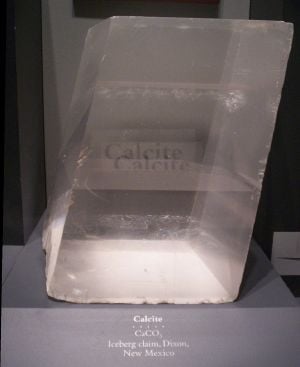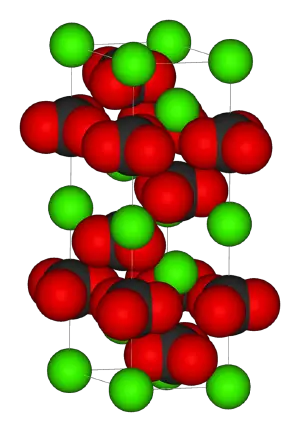Calcite
The carbonate mineral calcite is a chemical or biochemical calcium carbonate corresponding to the formula CaCO3 and is one of the most widely distributed minerals on the Earth's surface. It is a common constituent of sedimentary rocks, limestone in particular. It is also the primary mineral in metamorphic marble. It also occurs as a vein mineral in deposits from hot springs, and also occurs in caverns as stalactites and stalagmites. Calcite is often the primary constituent of the shells of marine organisms, e.g., plankton (such as coccoliths and planktic foraminifera), the hard parts of red algae, some sponges, brachiopoda, echinoderms, most bryozoa, and parts of the shells of some bivalves, such as oysters and rudists). Calcite represents the stable form of calcium carbonate; aragonite will change to calcite at 470°C.
Properties
Calcite crystals are hexagonal-rhombohedral, though actual calcite rhombohedrons are rare as natural crystals. However, they show a remarkable variety of habits including acute to obtuse rhombohedrons, tabular forms, prisms, or various scalenohedrons. Calcite exhibits several twinning types adding to the variety of observed forms. It may occur as fibrous, granular, lamellar, or compact. Cleavage is usually in three directions parallel to the rhombohedron form. Its fracture is conchoidal, but difficult to obtain.
It has a Mohs hardness of 3, a specific gravity of 2.71, and its luster is vitreous in crystallized varieties. Colour is white or colourless, though shades of gray, red, yellow, green, blue, violet, brown, or even black can occur when the mineral is charged with impurities. Calcite is transparent to opaque and may occasionally show phosphorescence or fluorescence. It is perhaps best known because of its power to produce strong double refraction of light, such that objects viewed through a clear piece of calcite appear doubled in all of their parts - a phenomenon first described by Rasmus Bartholin. A beautifully transparent variety used for optical purposes comes from Iceland, called Iceland spar. Acute scalenohedral crystals are sometimes referred to as "dogtooth spar".
Single crystals of calcite display an optical property called birefringence. The birefringent effect (using calcite) was first described by the Danish scientist Rasmus Bartholin in 1669. At a wavelength of ~590 nm calcite has ordinary and extraordinary refractive indices of 1.658 and 1.486, respectively [1].
Gallery
- Calcite Morocco.jpg
Calcite from Middle Atlas, Morocco
- Calcite09.jpg
Calcite from Montana, USA
Calcite In Literature
A form of calcite, Iceland spar plays a critical role in the plot of Against the Day by Thomas Pynchon. The same form is referred to in The Amber Spyglass by Philip Pullman as it has very similar properties to a mineral found in that story.
See also
- Monohydrocalcite - CaCO3.H2O
- Ikaite - CaCO3.6H2O
- List of minerals
- Lysocline
- Ocean acidification
ReferencesISBN links support NWE through referral fees
Further reading
- Schmittner Karl-Erich and Giresse Pierre, 1999. Micro-environmental controls on biomineralization: superficial processes of apatite and calcite precipitation in Quaternary soils, Roussillon, France. Sedimentology 46/3: 463-476.
External links
bg:Калцит ca:Calcita cs:Kalcit da:Kalk (mineral) de:Calcit et:Kaltsiit es:Calcita fa:کلسیت fr:Calcite it:Calcite he:קלציט lv:Kalcīts lt:Kalcitas hu:Kalcit nl:Calciet ja:方解石 no:Kalk (mineral) pl:Kalcyt pt:Calcita ro:Calcit ru:Кальцит sk:Kalcit fi:Kalsiitti sv:Kalkspat vi:Canxit tr:Kalsit zh:方解石





